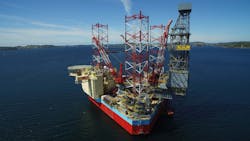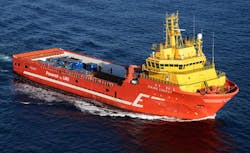Offshore drilling rig contractors and support vessel operators are increasingly developing and using technologies that not only reduce emissions but also improve operational efficiency and sustainability.
Maersk Drilling is converting two ultra-harsh environment jackups into hybrid, low-emission rigs. The company is performing the work on the Maersk Intrepid in co-operation with Equinor and on the Maersk Integrator with Aker BP. The upgrades involve running the rigs on hybrid power with low levels of nitrogen oxide (NOx) emissions, and adding data intelligence to further reduce energy consumption and carbon dioxide (CO2) emissions.
The upgrades have financial support from the Norwegian NOx Fund, an industry arrangement dedicated to reducing NOx emissions.
The low-emission upgrades comprise:
Hybrid power. Energy use onboard a rig is characterized by high peak loads during certain operations. Through use of batteries for energy storage, power will be instantly available when needed: this means that fewer engines operating at a higher intensity can supply basic energy requirements, an arrangement said to be more efficient and with lower CO2 emissions.
Energy emission efficiency software. The drilling contractor’s cloud-based energy emission efficiency (EEE) software employs real-time data to monitor all energy use onboard the rig, allowing for continuous optimization. For example, by switching off engines when they are not needed. Live tests of EEE have demonstrated a high energy saving potential, the company claimed.
SCR units to reduce NOx emissions. Selective catalytic reduction (SCR) systems capture NOx exhausts and use ammonia injections to convert the gas into water and nitrogen. By installing SCR units on the rig’s engine exhaust pipes, the company expects to cut NOx emissions by more than 90%, while also reducing soot emissions.
Last October, Transocean Ltd. deployed what it claimed is the world’s first hybrid energy storage system onboard a floating drilling unit. The system is now operational on the semisubmersible Transocean Spitsbergen, which is drilling at the Equinor-operated Snorre field offshore Norway.
Transocean’s patented hybrid power technology, developed in partnership with Aspin Kemp and Associates, is said to reduce fuel consumption and increase a dynamically positioned (DP) rig’s station-keeping reliability by capturing energy generated during normal rig operations that would otherwise be wasted, and storing it in batteries. This energy is then used to power the rig’s thrusters.
This operational and safety enhancement targets a 14% reduction in fuel use during normal operations, leading to a reduction in NOx and CO2 emissions.
The drilling contractor’s investment is funded in part through fuel saving incentives in its contract with Equinor and by the NOx Fund.
President and CEO Jeremy Thigpen said: “This first of its kind hybrid power upgrade will further enhance the reliability of our operations, while simultaneously reducing fuel consumption, operating costs, and our environmental footprint.”
Last November, Northern Ocean’s West Mira became the first rig in operation to be awarded the DNV GL Battery (Power) class notation. The ultra-deepwater semisubmersible operates a hybrid power plant using lithium-ion batteries as spinning reserve in DP operations and to supply power during peak load times.
Siemens’ BlueVault lithium-ion battery technology consists of four converter-battery systems for a total maximum power of 6 MW. The company estimated the energy storage solution will reduce the runtime of the rig’s on-platform diesel engines by 42%, cutting CO2 emissions by 15% and NOx emissions by 12%.
“The integration of energy storage with the power supply and distribution system of a drilling rig represents an important step towards improving the environmental sustainability of the offshore oil and gas industry,” said Bjørn Einar Brath, Head of Offshore Solutions in Siemens. “Offshore rigs have highly variable power consumption for drilling and dynamic positioning. By incorporating energy storage, it is possible to reduce the runtime of diesel engines and also keep them operating on an optimized combustion level. This ultimately leads to lower emissions.”
The batteries will be charged from the rig’s diesel-electric generators and used for supplying power during peak load times. In addition, they will serve as backup to prevent blackout situations and provide power to the thrusters in the unlikely event of loss of all running machinery.
Many offshore support vessel owners are also embracing hybrid power technology.
Wärtsilä is supplying hybrid propulsion systems to Eidesvik Offshore’s construction vessel Viking Neptun, Atlantic Offshore’s supply vessels Ocean Star and Ocean Art, and Acta Marine’s DP-2 walk-to-work construction support vessel Acta Centaurus.
Wärtsilä said its solution should deliver further benefits in the form of fuel cost savings, better environmental performance, and lower maintenance costs as the load on the engines should be more efficient and the running hours reduced.
Also, Yxney Maritime and Grieg Connect are collaborating with the Norwegian NOx Fund to develop a data-driven digital solution for automated NOx emissions reporting. Support vessel operator Solstad Offshore is one of two companies participating in the pilot phase of the project.
Historically calculating and reporting emissions has been left to shipowners to perform manually, which leaves a relatively large margin for error, while at the same time adding to the workload of the crew and onshore staff.
The new NOxDigital solution will be designed to provide a digital infrastructure for emissions reporting based on the Yxney Maress software for monitoring fleet energy consumption and Grieg Connect’s platform for high-resolution position data and geo-fencing technology. It will automatically detect whether a vessel is operating in taxable waters, with the picture completed by data on energy use and AIS data, displayed on a digital dashboard for each user.
“With full control over fuel consumption, location, and vessel activity, we can provide a much more accurate emissions picture than with manual estimations,” said Svein Erik Isaksen, HSEQ Environmental Engineer at Solstad Offshore. “And since all the data is digitalized, reporting can be automated, which in turn will lead to higher quality and more consistency in the emission reporting.”
Ammonia and hydrogen
Another way the offshore industry is assisting the energy transition is by exploring alternative, low-emissions fuels. Shipowners see ammonia and hydrogen as the most attractive fuel options for the long term, according to a recent ABS survey. When asked which fuel is most likely to be adopted in the near term, 70% selected fuels in the light gas pathway, which includes LNG in the short term and hydrogen as a future solution.
Equinor and Eidesvik are modifying the supply vessel Viking Energy to make it capable of covering long distances fueled by ammonia. The vessel is part of a research project that is developing, installing, and testing long-distance sailing fueled by carbon-free ammonia fuel cells. The technology will be tested on the vessel in 2024.
Equinor is part of the ShipFC project, a consortium of 14 European companies and institutions coordinated by NCE Maritime Cleantech. The main partners of the five-year research project are NCE Maritime Cleantech, Eidesvik, Wärtsilä, Prototech, and Equinor. Wärtsilä will deliver the power technology and ammonia storage and distribution systems. Prototech will deliver the fuel cell system.
The project will test whether the technology can deliver 100% carbon-free power over long distances.
Vermund Hjelland, vice president of technology and development at Eidesvik, said: “As part of the testing, the vessel will use ammonia in transit between harbor and offshore installations for one year. In addition, we envisage that ammonia will be used to power the vessel when alongside quay.
“Our ambition is that 60 to 70% of the energy consumption will come from ammonia during the test period. In addition, we want to demonstrate that the technology can supply up to 90% of the total power demand.”
The vessel will still be able to use LNG as fuel, and the remaining power requirement will be met by battery.
Ammonia research on the Viking Energy has a budget of NOK 230 million ($26 million), a substantial part of which is EU funded.
Since the early 2000s, Equinor has addressed ways of cutting emissions from supply vessels on the Norwegian continental shelf. The Viking Energy was the first LNG-fueled vessel in its fleet in 2003, and the first vessel with hybrid battery power in 2016. During 2020, all the 19 supply vessels on long-term contracts with the company will feature battery power and power from shore.
Late last year Ulstein Design & Solutions BV and Nedstack Fuel Cell Technology BV introduced the first complete hydrogen-fueled vessel design. The ULSTEIN SX190 Zero Emission construction support vessel is Ulstein’s first hydrogen-powered offshore vessel, featuring a Nedstack fuel cell power system. The DP-2 vessel can cater for a variety of offshore support operations, the company said.
This design uses proven and available technology, enabling clean shipping operations to reduce the environmental footprint of offshore projects. CO2, NOx, and particle emissions are eliminated when using hydrogen fuel cells.
The first vessel can be delivered in three years, according to Ulstein. Sea trials of a newbuild could happen as soon as 2022.
With today’s technology, the ULSTEIN SX190 design can operate four days in zero-emission mode. However, with the developments in hydrogen storage and fuel cell technologies, a future zero-emission endurance of up to two weeks is targeted, the company said. For extended missions and capabilities, the vessel can fall back on its more conventional diesel-electric system using low sulphur marine diesel oil.
The new design is based on the company’s existing SX190 vessel platform and has a total installed power of 7.5 MW, of which 2 MW is generated by a fuel cell power system, typically Nedstack proton exchange membrane (PEM) fuel cells, which are in a separate, second engine room.
PEM fuel cells convert hydrogen and air into electric power, heat, and water and produce no emissions in the process. The PEM fuel cells used in the design are fueled by hydrogen from containerized pressure vessels. These hydrogen storage containers can be loaded and unloaded by normal container handling operations and equipment. The hydrogen containers can be refilled at hydrogen production sites, either from industry by-product hydrogen or green hydrogen from electrolysis.
As for the offshore wind market, Edda Wind is building two commissioning service operation vessels and two service operations vessels that will feature technology that reduce greenhouse gas emissions by a minimum of 30%. In addition, they will be prepared for installation of zero emission hydrogen technology.
The preparations for future zero emission propulsion systems are made possible by Enova funding, the company said. The upgrades include complete tank systems for hydrogen storage, dedicated machinery space for fuel cells, battery hybrid system, novel type propulsors and an extensive package of energy saving measures for most auxiliary systems such as HVAC and pumps systems.





